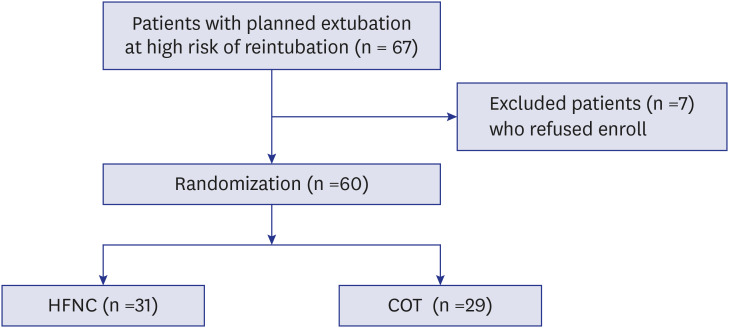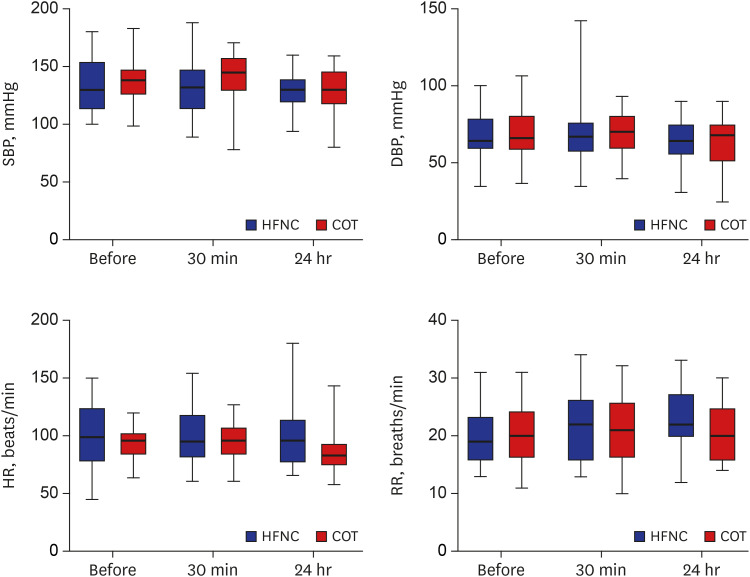J Korean Med Sci.
2020 Jun;35(25):e194. 10.3346/jkms.2020.35.e194.
Comparison of Postextubation Outcomes Associated with High-Flow Nasal Cannula vs. Conventional Oxygen Therapy in Patients at High Risk of Reintubation: a Randomized Clinical Trial
- Affiliations
-
- 1Department of Internal Medicine, Chungbuk National University Hospital, Chungbuk National University College of Medicine, Cheongju, Korea
- KMID: 2503657
- DOI: http://doi.org/10.3346/jkms.2020.35.e194
Abstract
- Background
Liberation and extubation are important for patients supported by mechanical ventilation. Extubation success is related to the duration of an intensive care unit (ICU) stay and mortality rate. High-flow nasal cannula (HFNC) oxygen therapy has physiological and clinical benefits in respiratory care. The present study compared clinical outcomes associated with HFNC and conventional oxygen therapy (COT) among patients at high risk for reintubation.
Methods
A single-center randomized clinical trial was conducted between March 2018 and June 2019. Sixty adults admitted to the ICU and who were at high-risk of reintubation and met the inclusion criteria were enrolled in this study. “High risk” for reintubation was defined as having at least one of the following risk factors: age > 65 years, Acute Physiology and Chronic Health Evaluation II score > 12 points on extubation day, obesity, poor expectoration, airway patency problems, difficult or prolonged weaning, and more than one comorbidity. The primary outcome of interest was reintubation within 72 hours. Secondary outcomes included duration of ICU and hospital stay, mortality rate, and time to reintubation.
Results
Of 60 patients, 31 received HFNC and 29 received COT (mean age, 78 ± 7.8 vs. 76 ± 6.5 years, respectively). Reintubation rate within 72 hours did not differ between the groups (3 patients [9.7%] vs. 1 patient [3.4%], respectively). Reintubation time was shorter among patients who received COT than among patients who received HFNC (0.5 hour vs. 25 hours), but this difference was not statistically significant. Duration of ICU did not differ between the groups (14.7 ± 9.6 days vs. 13.8 ± 15.7 days, for HFNC and COT, respectively).
Conclusion
Among patients at high risk for reintubation, compared with COT, HFNC did not reduce the risk of reintubation within 72 hours.
Keyword
Figure
Reference
-
1. Cuquemelle E, Pham T, Papon JF, Louis B, Danin PE, Brochard L. Heated and humidified high-flow oxygen therapy reduces discomfort during hypoxemic respiratory failure. Respir Care. 2012; 57(10):1571–1577. PMID: 22417569.
Article2. Frat JP, Brugiere B, Ragot S, Chatellier D, Veinstein A, Goudet V, et al. Sequential application of oxygen therapy via high-flow nasal cannula and noninvasive ventilation in acute respiratory failure: an observational pilot study. Respir Care. 2015; 60(2):170–178. PMID: 25294935.
Article3. Maggiore SM, Idone FA, Vaschetto R, Festa R, Cataldo A, Antonicelli F, et al. Nasal high-flow versus Venturi mask oxygen therapy after extubation. Effects on oxygenation, comfort, and clinical outcome. Am J Respir Crit Care Med. 2014; 190(3):282–288. PMID: 25003980.
Article4. Sztrymf B, Messika J, Bertrand F, Hurel D, Leon R, Dreyfuss D, et al. Beneficial effects of humidified high flow nasal oxygen in critical care patients: a prospective pilot study. Intensive Care Med. 2011; 37(11):1780–1786. PMID: 21946925.
Article5. Zhu Y, Yin H, Zhang R, Wei J. High-flow nasal cannula oxygen therapy versus conventional oxygen therapy in patients with acute respiratory failure: a systematic review and meta-analysis of randomized controlled trials. BMC Pulm Med. 2017; 17(1):201. PMID: 29237436.
Article6. Epstein SK, Ciubotaru RL. Independent effects of etiology of failure and time to reintubation on outcome for patients failing extubation. Am J Respir Crit Care Med. 1998; 158(2):489–493. PMID: 9700126.
Article7. Frutos-Vivar F, Esteban A, Apezteguia C, González M, Arabi Y, Restrepo MI, et al. Outcome of reintubated patients after scheduled extubation. J Crit Care. 2011; 26(5):502–509. PMID: 21376523.
Article8. Rittayamai N, Tscheikuna J, Rujiwit P. High-flow nasal cannula versus conventional oxygen therapy after endotracheal extubation: a randomized crossover physiologic study. Respir Care. 2014; 59(4):485–490. PMID: 24046462.
Article9. Hernández G, Vaquero C, González P, Subira C, Frutos-Vivar F, Rialp G, et al. Effect of postextubation high-flow nasal cannula vs conventional oxygen therapy on reintubation in low-risk patients: a randomized clinical trial. JAMA. 2016; 315(13):1354–1361. PMID: 26975498.10. Brotfain E, Zlotnik A, Schwartz A, Frenkel A, Koyfman L, Gruenbaum SE, et al. Comparison of the effectiveness of high flow nasal oxygen cannula vs. standard non-rebreather oxygen face mask in post-extubation intensive care unit patients. Isr Med Assoc J. 2014; 16(11):718–722. PMID: 25558703.11. Zhu Y, Yin H, Zhang R, Ye X, Wei J. High-flow nasal cannula oxygen therapy versus conventional oxygen therapy in patients after planned extubation: a systematic review and meta-analysis. Crit Care. 2019; 23(1):180. PMID: 31101127.
Article12. Zhu Y, Yin H, Zhang R, Wei J. High-flow nasal cannula oxygen therapy vs conventional oxygen therapy in cardiac surgical patients: a meta-analysis. J Crit Care. 2017; 38:123–128. PMID: 27886577.
Article13. Kwak SH, Jeong CW, Lee SH, Lee HJ, Koh Y. Current status of intensive care units registered as critical care subspecialty training hospitals in Korea. J Korean Med Sci. 2014; 29(3):431–437. PMID: 24616595.
Article14. Ferrer M, Valencia M, Nicolas JM, Bernadich O, Badia JR, Torres A. Early noninvasive ventilation averts extubation failure in patients at risk: a randomized trial. Am J Respir Crit Care Med. 2006; 173(2):164–170. PMID: 16224108.15. Thille AW, Harrois A, Schortgen F, Brun-Buisson C, Brochard L. Outcomes of extubation failure in medical intensive care unit patients. Crit Care Med. 2011; 39(12):2612–2618. PMID: 21765357.
Article16. El-Solh AA, Aquilina A, Pineda L, Dhanvantri V, Grant B, Bouquin P. Noninvasive ventilation for prevention of post-extubation respiratory failure in obese patients. Eur Respir J. 2006; 28(3):588–595. PMID: 16737982.17. Nava S, Gregoretti C, Fanfulla F, Squadrone E, Grassi M, Carlucci A, et al. Noninvasive ventilation to prevent respiratory failure after extubation in high-risk patients. Crit Care Med. 2005; 33(11):2465–2470. PMID: 16276167.
Article18. Fernandez R, Subira C, Frutos-Vivar F, Rialp G, Laborda C, Masclans JR, et al. High-flow nasal cannula to prevent postextubation respiratory failure in high-risk non-hypercapnic patients: a randomized multicenter trial. Ann Intensive Care. 2017; 7(1):47. PMID: 28466461.
Article19. Hernández G, Vaquero C, Colinas L, Cuena R, González P, Canabal A, et al. Effect of postextubation high-flow nasal cannula vs noninvasive ventilation on reintubation and postextubation respiratory failure in high-risk patients: a randomized clinical trial. JAMA. 2016; 316(15):1565–1574. PMID: 27706464.20. Yoo JW, Synn A, Huh JW, Hong SB, Koh Y, Lim CM. Clinical efficacy of high-flow nasal cannula compared to noninvasive ventilation in patients with post-extubation respiratory failure. Korean J Intern Med. 2016; 31(1):82–88. PMID: 26767861.
Article21. Song HZ, Gu JX, Xiu HQ, Cui W, Zhang GS. The value of high-flow nasal cannula oxygen therapy after extubation in patients with acute respiratory failure. Clinics (Sao Paulo). 2017; 72(9):562–567. PMID: 29069260.
Article22. Lu Z, Chang W, Meng SS, Zhang X, Xie J, Xu JY, et al. Effect of high-flow nasal cannula oxygen therapy compared with conventional oxygen therapy in postoperative patients: a systematic review and meta-analysis. BMJ Open. 2019; 9(8):e027523.
Article23. Takakuwa O, Oguri T, Asano T, Fukuda S, Kanemitsu Y, Uemura T, et al. Prevention of hypoxemia during endobronchial ultrasound-guided transbronchial needle aspiration: Usefulness of high-flow nasal cannula. Respir Investig. 2018; 56(5):418–423.
Article
- Full Text Links
- Actions
-
Cited
- CITED
-
- Close
- Share
- Similar articles
-
- Protecting Postextubation Respiratory Failure and Reintubation by High-Flow Nasal Cannula Compared to Low-Flow Oxygen System: Single Center Retrospective Study and Literature Review
- Study on the Changes of SaO2, According to the Different Type of Oxygen Suppliers
- Cardiac Dysfunction Is Not Associated with Increased Reintubation Rate in Patients Treated with Post-extubation High-Flow Nasal Cannula
- Early Use of High Flow Nasal Cannula in Postextubation Period: Can It Reduce Reintubation Rate?
- Early Use of High-Flow Nasal Cannula in Postextubation Period: Can It Reduce Reintubation Rate? Authors’ Reply




